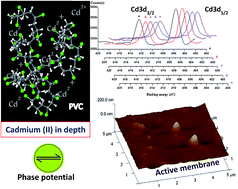Our official English website, www.x-mol.net, welcomes your
feedback! (Note: you will need to create a separate account there.)
Depth profiling X-ray photoelectron spectroscopy and atomic force microscopy of Cd(ii)- and Pb(ii)-selective electrodes based on nano metal sulfides
RSC Advances ( IF 3.9 ) Pub Date : 2018-01-17 00:00:00 , DOI: 10.1039/c7ra13168b Abdulhakeem A Ajadi 1 , Nadia M Shuaib 1 , Adel F Shoukry 1
RSC Advances ( IF 3.9 ) Pub Date : 2018-01-17 00:00:00 , DOI: 10.1039/c7ra13168b Abdulhakeem A Ajadi 1 , Nadia M Shuaib 1 , Adel F Shoukry 1
Affiliation

|
This research involved constructing and studying plastic membrane Cd(II)- and Pb(II)-ion selective electrodes of the coated wire type based on nanoparticles of CdS and PbS as ionophores, respectively. The electrodes exhibited average linear concentration ranges of 1.0 × 10−6 to 1.0 × 10−2 and 9.6 × 10−7 to 1.0 × 10−2 M, average detection limits of 8.6 × 10−7 and 5.8 × 10−7 M, pH ranges of 2.2–5.8 and 2.9–5.9, and average calibration graph slopes of 28.56 and 28.81 mV per concentration decade, respectively. Both electrodes showed high selectivity towards many inorganic cations. Depth profiling X-ray photoelectron spectroscopy of fresh and expired membranes proved that: (a) the nanoparticles were homogeneously dissolved in the polymeric network and (b) the limitation of the life span of the plastic membrane was due to leaching of the active ingredient from the membrane surface to the bathing solution. The topography of fresh, active, and expired membranes as imaged by atomic force microscopy revealed the formation of a gel layer at the surface of the active electrode and drastic deformation of the expired membrane's surface.
中文翻译:

基于纳米金属硫化物的 Cd(ii) 和 Pb(ii) 选择性电极的深度剖析 X 射线光电子能谱和原子力显微镜
本研究涉及构建和研究分别基于 CdS 和 PbS 纳米粒子作为离子载体的涂层线型塑料膜 Cd( II )-和 Pb( II )-离子选择性电极。电极表现出1.0×10 -6至1.0×10 -2和9.6×10 -7至1.0×10 -2 M的平均线性浓度范围,8.6×10 -7和5.8×10 -7 M的平均检测限, pH 范围为 2.2–5.8 和 2.9–5.9,每个浓度十年的平均校准图斜率分别为 28.56 和 28.81 mV。两种电极对许多无机阳离子均表现出高选择性。新鲜和过期膜的深度分析 X 射线光电子能谱证明:(a) 纳米颗粒均匀溶解在聚合物网络中,(b) 塑料膜寿命的限制是由于活性成分从膜中浸出所致。将膜表面浸入沐浴液中。通过原子力显微镜成像的新鲜膜、活性膜和过期膜的形貌显示,活性电极表面形成了凝胶层,并且过期膜表面发生了剧烈变形。
更新日期:2018-01-17
中文翻译:

基于纳米金属硫化物的 Cd(ii) 和 Pb(ii) 选择性电极的深度剖析 X 射线光电子能谱和原子力显微镜
本研究涉及构建和研究分别基于 CdS 和 PbS 纳米粒子作为离子载体的涂层线型塑料膜 Cd( II )-和 Pb( II )-离子选择性电极。电极表现出1.0×10 -6至1.0×10 -2和9.6×10 -7至1.0×10 -2 M的平均线性浓度范围,8.6×10 -7和5.8×10 -7 M的平均检测限, pH 范围为 2.2–5.8 和 2.9–5.9,每个浓度十年的平均校准图斜率分别为 28.56 和 28.81 mV。两种电极对许多无机阳离子均表现出高选择性。新鲜和过期膜的深度分析 X 射线光电子能谱证明:(a) 纳米颗粒均匀溶解在聚合物网络中,(b) 塑料膜寿命的限制是由于活性成分从膜中浸出所致。将膜表面浸入沐浴液中。通过原子力显微镜成像的新鲜膜、活性膜和过期膜的形貌显示,活性电极表面形成了凝胶层,并且过期膜表面发生了剧烈变形。











































 京公网安备 11010802027423号
京公网安备 11010802027423号